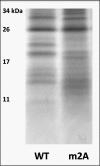Interactions between copper-binding sites determine the redox status and conformation of the regulatory N-terminal domain of ATP7B
- PMID: 20032459
- PMCID: PMC2825428
- DOI: 10.1074/jbc.M109.074633
Interactions between copper-binding sites determine the redox status and conformation of the regulatory N-terminal domain of ATP7B
Abstract
Copper-transporting ATPase ATP7B is essential for human copper homeostasis and normal liver function. ATP7B has six N-terminal metal-binding domains (MBDs) that sense cytosolic copper levels and regulate ATP7B. The mechanism of copper sensing and signal integration from multiple MBDs is poorly understood. We show that MBDs communicate and that this communication determines the oxidation state and conformation of the entire N-terminal domain of ATP7B (N-ATP7B). Mutations of copper-coordinating Cys to Ala in any MBD (2, 3, 4, or 6) change the N-ATP7B conformation and have distinct functional consequences. Mutating MBD2 or MBD3 causes Cys oxidation in other MBDs and loss of copper binding. In contrast, mutation of MBD4 and MBD6 does not alter the redox status and function of other sites. Our results suggest that MBD2 and MBD3 work together to regulate access to other metal-binding sites, whereas MBD4 and MBD6 receive copper independently, downstream of MBD2 and MBD3. Unlike Ala substitutions, the Cys-to-Ser mutation in MBD2 preserves the conformation and reduced state of N-ATP7B, suggesting that hydrogen bonds contribute to interdomain communications. Tight coupling between MBDs suggests a mechanism by which small changes in individual sites (induced by copper binding or mutation) result in stabilization of distinct conformations of the entire N-ATP7B and altered exposure of sites for interactions with regulatory proteins.
Figures









Similar articles
-
Dynamics of the metal binding domains and regulation of the human copper transporters ATP7B and ATP7A.IUBMB Life. 2017 Apr;69(4):226-235. doi: 10.1002/iub.1611. Epub 2017 Mar 8. IUBMB Life. 2017. PMID: 28271598 Review.
-
Copper binding to the N-terminal metal-binding sites or the CPC motif is not essential for copper-induced trafficking of the human Wilson protein (ATP7B).Biochem J. 2007 Jan 1;401(1):143-53. doi: 10.1042/BJ20061055. Biochem J. 2007. PMID: 16939419 Free PMC article.
-
The loop connecting metal-binding domains 3 and 4 of ATP7B is a target of a kinase-mediated phosphorylation.Biochemistry. 2009 Jun 23;48(24):5573-81. doi: 10.1021/bi900325k. Biochemistry. 2009. PMID: 19405516 Free PMC article.
-
Dynamics and stability of the metal binding domains of the Menkes ATPase and their interaction with metallochaperone HAH1.Biochemistry. 2012 Nov 6;51(44):8885-906. doi: 10.1021/bi300669e. Epub 2012 Oct 26. Biochemistry. 2012. PMID: 23075277
-
Mechanism of tumor resistance to cisplatin mediated by the copper transporter ATP7B.Biochem Cell Biol. 2011 Apr;89(2):138-47. doi: 10.1139/o10-150. Biochem Cell Biol. 2011. PMID: 21455266 Review.
Cited by
-
Disease-causing point-mutations in metal-binding domains of Wilson disease protein decrease stability and increase structural dynamics.Biometals. 2017 Feb;30(1):27-35. doi: 10.1007/s10534-016-9976-7. Epub 2016 Oct 15. Biometals. 2017. PMID: 27744583 Free PMC article.
-
Copper binding leads to increased dynamics in the regulatory N-terminal domain of full-length human copper transporter ATP7B.PLoS Comput Biol. 2022 Sep 7;18(9):e1010074. doi: 10.1371/journal.pcbi.1010074. eCollection 2022 Sep. PLoS Comput Biol. 2022. PMID: 36070320 Free PMC article.
-
The six metal binding domains in human copper transporter, ATP7B: molecular biophysics and disease-causing mutations.Biometals. 2017 Dec;30(6):823-840. doi: 10.1007/s10534-017-0058-2. Epub 2017 Oct 23. Biometals. 2017. PMID: 29063292 Free PMC article. Review.
-
The CopA2-Type P1B-Type ATPase CcoI Serves as Central Hub for cbb 3-Type Cytochrome Oxidase Biogenesis.Front Microbiol. 2021 Sep 13;12:712465. doi: 10.3389/fmicb.2021.712465. eCollection 2021. Front Microbiol. 2021. PMID: 34589071 Free PMC article.
-
At sixes and sevens: cryptic domain in the metal binding chain of the human copper transporter ATP7A.Biophys J. 2021 Oct 19;120(20):4600-4607. doi: 10.1016/j.bpj.2021.08.029. Epub 2021 Aug 28. Biophys J. 2021. PMID: 34461106 Free PMC article.
References
Publication types
MeSH terms
Substances
Grants and funding
LinkOut - more resources
Full Text Sources
Molecular Biology Databases
Miscellaneous

